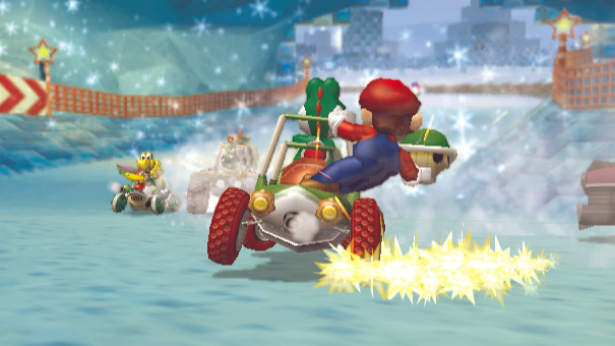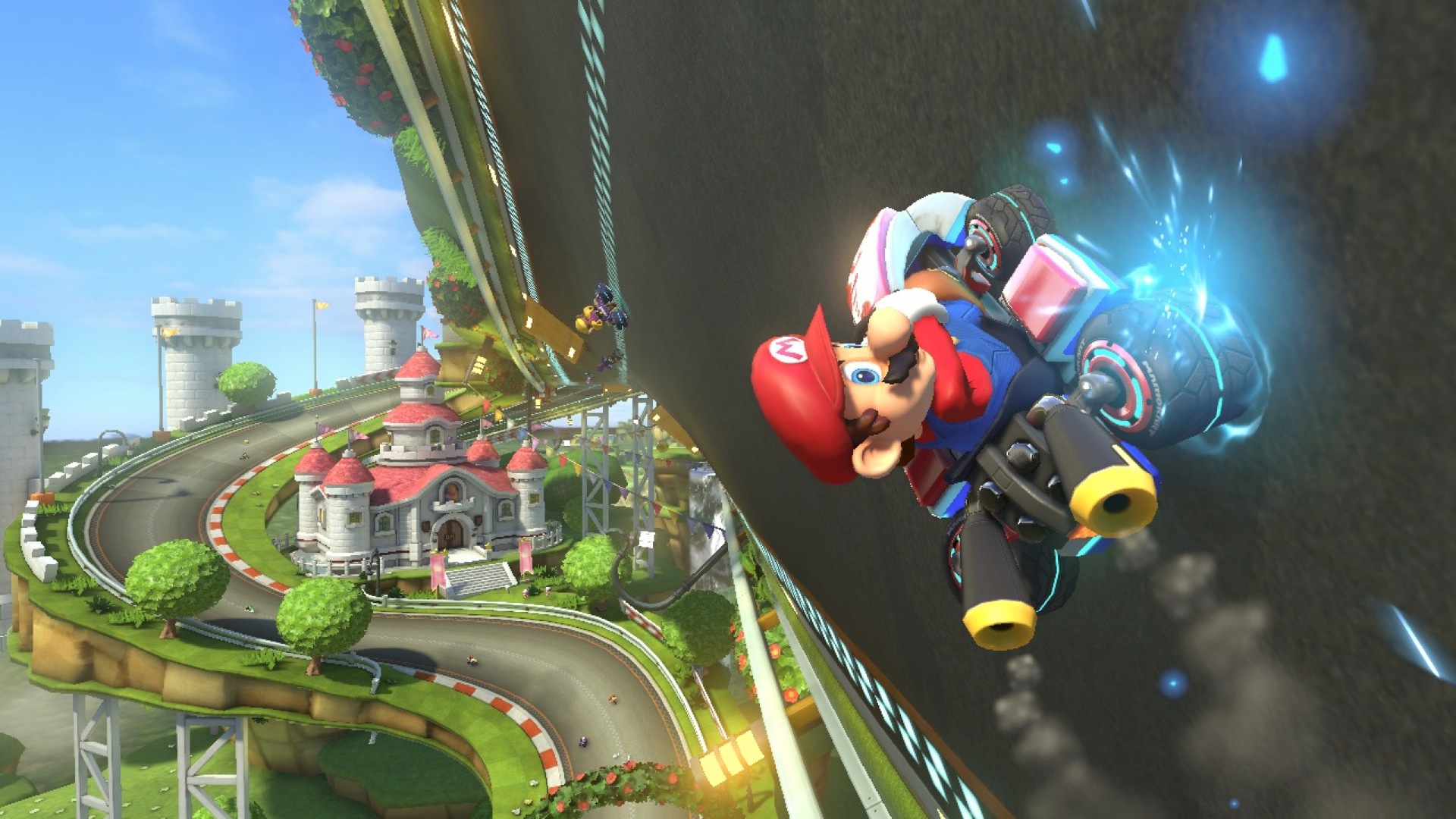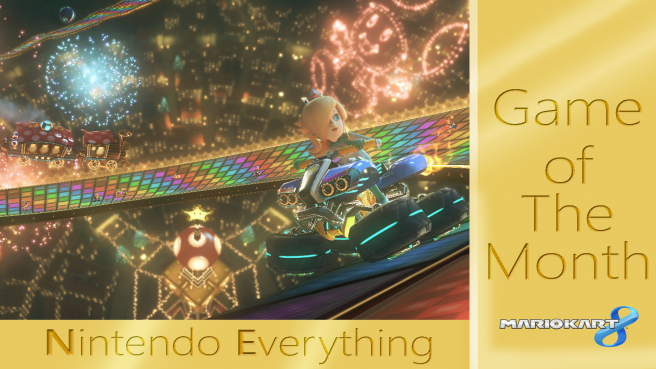[Feature] How Mario Kart 8 continues to breathe new life into a once-stagnant series
The illustrious Mario Kart is a series that’s been around since SNES and has touched the hearts of millions across the globe with its simplistic-yet-addictive and sometimes-competitive gameplay. We’ve seen the series grow exponentially in features and gimmicks with each new generational entry, but there’s always been one thing in particular that they’ve all had in common that was causing the series to dwindle in its excitement and keeping it from its full potential: speed.
Now, just to be clear, I’ve always loved and will continue to love Mario Kart. It’s held a special place in my heart since I first played it as a child on the Nintendo 64, but as I’ve grown and watched it evolve with each new entry, whether handheld or console, my interest in Mario Kart began to tank, specifically after Double Dash!!. I didn’t have any animosity towards the series (except for Mario Kart Wii) – it’ll always be in a league of its own – but as I began to delve into other racing games across various platforms, quickly becoming one of my favorite genres, it was hard to go back to Mario Kart expecting an immersive, adrenaline-fueled experience games like Burnout, Need for Speed, Extreme G Racing, or F-Zero would give me. After a while, even games that had the same power-up/items mechanics it had like Wipeout, Blur, Split/Second and, in a more obscure sense, Twisted Metal started to feel superior to Mario Kart. I’d still go back and play Double Dash!! and 64 from time to time with friends, but despite the merriment of the occasion, I couldn’t play more than twenty minutes at a time before wanting to go to sleep. The excitement was lost for me. I preferred to watch from a distance.

Double Dash!! on the GameCube was the last one I truly enjoyed, but even its grip on me was starting to loosen as I started to experiment with other racing games. The game was unique with character-specific special items and two-character karting. It was always neat to try combinations with characters you normally wouldn’t see together and see what kind of strategies you could come up with. Everyone had their own style, and it was interesting to see how races would pan out. Despite adding a layer of thinking, great tracks, and a much more expansive roster (jumping from eight playable characters on the 64 to a whopping twenty for Double Dash!!), it still felt too slow. Unless you were in Baby Park, even tracks that were small felt like they took much longer than they needed to. Maybe more boost pads could have helped in some of the tracks, but even at 150cc it simply didn’t feel exciting enough.
Jumping over to Mario Kart Wii, we see the introduction of the wheel and online capabilities. This is where I completely lost interest and faith in Mario Kart. It wasn’t because of these new gimmicks and features, but the poor implementation of them that made me say “enough is enough – I’m done.”
The seventh generation of gaming is where the craze of high definition started to kick in. This is where I really became spoiled with the aforementioned games – primarily with Blur, Split/Second, and other smaller titles like Pure and Fatal Inertia EX. Not only did these titles give me the high-octane action I want in a racing game while also providing items to employ and utilize just like Mario Kart does, but they looked good doing it, were in 16:9, and didn’t make me feel like I was losing visual acuity.
With the wheel for Mario Kart Wii, you couldn’t get the accuracy of turning like a normal controller gave you. It didn’t feel immersive, wasn’t intuitive, and not very ergonomic despite the simple design. You had to turn the wheel in the direction you were going seconds before and hope the Wii would receive the inputs in time before crashing into a wall, grinding through grass, or finding yourself at the end of Lakitu’s fishing hook. Last second saves weren’t possible with the wheel. Even after Wii Motion Plus became standard for Wiimotes, improving the motion controls, the gimmick was still atrocious. The online component for Mario Kart Wii was also a huge let down as it made dial-up look like Road Runner. Simply finding others to be in a lobby with you was an abhorrent task and quickly caused most to give up once you realize you could have watched the entire Godfather trilogy by the end of it all. Whether it was on the track offline or with fans around the world online, the slow speed continued to linger.

Five years later after the release of Mario Kart Wii, the world was introduced to Mario Kart 8 at E3 2013. Immediately something clicked with me after the trailer debuted. Within two minutes, the terrible taste Mario Kart Wii put in my mouth and the melatonin-inducing gameplay of previous entries was gone. I didn’t know if it was the vibrant colors, the fact that it was in HD or the impeccable music, but I wanted more. The trailer wasn’t enough, so throughout the duration of E3 I went to find as many videos as possible. Every video I saw, whether it be a direct-feed or off-camera, had this sense of magic exuding from it. Was it the level design or any of the things I previously mentioned? I still didn’t know. After myriad hours watching videos and reading articles in the following weeks and months, it dawned on me what it was that appealed most to me – it felt faster.
Could it have been the 60 frames per second that made it feel faster? It’s a possibility, but this was before YouTube implemented 60fps support. Maybe it was the new anti-gravity gimmick that gave the game a more fluid feel. Whatever it was, this was precisely what I was looking for in Mario Kart the entire time. For the first time in a long time, I was excited to get my hands on Mario Kart, not only to play it, but to purchase it on launch day and play for as long as I could. Mario Kart 8 was my reboot.
Before the Wii U was even released, Bayonetta 2 had been announced as an upcoming exclusive title for the console. Having been a huge fan of the first and all of Hideki Kamiya’s work, this would be the title I would wait for to get me to buy a Wii U. Fast forward to May 30th, 2014, months before Bayonetta, and here I am walking out of a GameStop with a Wii U bundle for a game of a series that I had ceased interest in years ago and lost all hope for. Who would have thought? It was one of the few titles of 2014 that made me feel giddy, full of joy, and ecstatic about both Mario Kart and the future of the Wii U, and this was before I even had my hands on it. Imagine what I felt once it was in my possession, set up, and finally at Mario Kart 8’s start menu.
The first thing you notice right away after booting it up (which was also quick) is one of many of Mario Kart 8’s flawless compositions attack your ears with the biggest hug. The UI is beautiful, the sheer detail of the tracks and level design blew me away, and everything about it was bigger, better, and faster. 50cc – the slowest of the bunch – already felt like an improvement from previous games. It was still a little slow for me, though it certainly didn’t put me to sleep for once, but I still got through all the cups because I wanted to complete the entire thing and get all the stamps as well as all the other collectibles.
One of the most important aspects of Mario Kart 8 to me were the stats. The problem with Mario Kart before is it’s always felt more like “let’s see who the luckiest person is this race”, rather than actual driving ability or smart use of the items you acquire. The stats provide the game with more depth and give the player a better connection to a character or set up depending on how they play.
The depth and fact that every character, kart, wheel and glider finally have meaning, substance and merit without getting too convoluted, as opposed to just pick whatever and go – because there was usually such a heavy reliance on items and who could get more blue shells and mushrooms than the other – really made me feel like there was purpose in what, how, and who I was playing. The feeling was very reminiscent of other intricate racing titles and Super Smash Bros.
The items are here to aid you to victory and protect you along the line, not be the determining factor on whether you get 1st place or last. Coins as items prove this, as once you get to first place, that’s basically all you receive, with the occasional green shell, and, if you’re really lucky, the Blue Shell destroying speaker. Despite coins being 70% of what you get when you go through item boxes in first place, you can still maintain that position the whole way through if you know what you’re doing and have got a good setup, even if you’re in 1st from the start of the race.
Speed is made more fun by drifting. Drifting will allow you to go through sharp corners with relative ease and also be a factor in your victory. The ones that don’t drift are the ones that lose, and I don’t mean lose as in not first place (I’d say you’re still a winner if you’re 5th and above online), I mean lose as in consistently being 9th and below and potentially being lapped.
The online component of Mario Kart 8 is also fast. Finding others to get into a lobby is extremely easy, and you’re usually up and running into a race within a minute. The online is consistently smooth and is actually quite remarkable in terms of stability and functionality, something that Mario Kart Wii did not have. Everything Mario Kart also does in terms of online such as Miiverse and Mario Kart TV is also a great addition and adds another level of depth to the series. It is exciting to see other people post videos on Miiverse and online to YouTube of races they’ve had and everything that occurred within them. Since everything in the game from the characters to the maps to the karts all have their own personality now, it’s amazing – and often hilarious – to see the things that transpire. Every video and post is unique in its own way and really adds to the lure and immersion of Mario Kart. Mario Kart 8 doesn’t feel like just a game anymore. It’s become a platform where fans from all around the world come together, play, and share special moments through screenshots and videos with Miiverse as its hub – the new one stop shop for all things Mario Kart.
With solid internet capabilities, we get the addition of DLC. DLC further keeps Mario Kart 8 fresh and wanting you to come back for more. Not only did I play Mario Kart 8 every day for 4-5 months straight, but after a quick break I ended up coming back for more with DLC pack 1 which added new cups, characters, and karts. Now with DLC 2 coming in a few weeks, 150cc is about to be left in the dust by 200cc, a first for the series. Yes, we’re going faster.
It goes without saying that the trailer and comparison videos have me excited beyond belief. It is absurdly fast, and I am in love with it. I haven’t played Mario Kart 8 in about two months, so I’m elated to get back into it going even faster than ever before. No Mario Kart has provided me with as much exuberance, content, and replayability as much as the eighth installment has and continues to do.
When it comes to racing, whether it be a simulator like Forza and Gran Turismo, karting like Diddy Kong Racing and Sonic & All Stars Racing Transformed, or arcade racing like Midnight Club and Ridge Racer, faster will always be better. Let’s be honest with ourselves, F-Zero wouldn’t be as popular and beloved as it is if it played a little more like Big Mutha Truckers.
